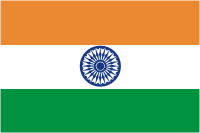
The KV schools have an Autumn break that coincides nicely with the Dussera Festival (more on this to come later) which honors the goddess Durga. We packed up our bags for 12 days and headed south on the Deccan peninsula for what would be a splendid break from my new routine here.
Erin McGraw, another US Fulbright teacher (who is working in Hyderabad about one hour from where we are in Secunderabad) joined us for the trip on an early flight to the southern state of Kerala (pronounced key-air-a-la). Kerala is an interesting place - protected on the east from the "Western Ghats" - a set of mountains that bisects the lower portion of the Deccan peninsula and on the west by the Arabian Sea. This relative isolation has A unique set of customs, food, and language (called Malayalam, a palindrome and one of the many regional derivatives of Sanskrit).
We started our adventure with a flight to Kochin, a coastal town at about the midpoint in the state. We ran into other western tourists for the first time in months, including a few Americans wearing Red Sox hats - you can imagine what we ended up talking about!

The highlight of my trip to Kochin was a three-hour Kathakali performance - the regional Keralean dance. A casual observer might find it akin to sign language - but what it lacks in efficient utility it more than compensates for in fluid, dancelike motions of the hands and face. There is no elaborate footwork, props, or stage - rather the attention of the audience is directed to the face of the performer, his exquisite costume, and the unbelievable, nearly characaturelike movements of the face. The production is accompanied by four or five musicians including two large upright drums, which direct the overall tempo of the song, one bongo style hand-tapped horizontal drum, and an accordion type of instrument which was played by the singer/narrator who juxtaposed a trance-like vocal harmony (similar to mantra) against powerful percussion rhythms.

India as a whole is littered with monuments to its recent colonial past - largely European efforts to control the spice trade and profit from this fertile region, but also in aggressive religious conversion efforts. The Portuguese seafarers of the 16th century established missions and posts in Fort Kochin, but their influence was limited to this small area and the larger northern colony at Goa. Vasco de Gama, the explorer, died and was buried here, but was later exhumed and brought back to Lisbon. The large Portuguese gates and terra cotta rooftops and gables reminded me of this colonial past.
The French also traded from the eastern side of the Deccan just south of Chennai (Madras) in Pondicherry while the English, originally as the East India Company from Calcutta, would eventually colonize the entire subcontinent and rule from the newly established capital city in New Delhi. It would be a few hundred years before eventual Indian independance in 1947.
 The KV schools have an Autumn break that coincides nicely with the Dussera Festival (more on this to come later) which honors the goddess Durga. We packed up our bags for 12 days and headed south on the Deccan peninsula for what would be a splendid break from my new routine here.
The KV schools have an Autumn break that coincides nicely with the Dussera Festival (more on this to come later) which honors the goddess Durga. We packed up our bags for 12 days and headed south on the Deccan peninsula for what would be a splendid break from my new routine here. India as a whole is littered with monuments to its recent colonial past - largely European efforts to control the spice trade and profit from this fertile region, but also in aggressive religious conversion efforts. The Portuguese seafarers of the 16th century established missions and posts in Fort Kochin, but their influence was limited to this small area and the larger northern colony at Goa. Vasco de Gama, the explorer, died and was buried here, but was later exhumed and brought back to Lisbon. The large Portuguese gates and terra cotta rooftops and gables reminded me of this colonial past.
India as a whole is littered with monuments to its recent colonial past - largely European efforts to control the spice trade and profit from this fertile region, but also in aggressive religious conversion efforts. The Portuguese seafarers of the 16th century established missions and posts in Fort Kochin, but their influence was limited to this small area and the larger northern colony at Goa. Vasco de Gama, the explorer, died and was buried here, but was later exhumed and brought back to Lisbon. The large Portuguese gates and terra cotta rooftops and gables reminded me of this colonial past.




1 comment:
Hi Patrick, quite an engrossing blog, do keep writing. I lived in Amherst (MA) and Boston before moving back to Hyderabad. Having observed America and America observing me, I'm always trying to observe Americans observing India in India, if that makes any sense :)
I stumbled on your blog when I Googled "World Series" and "Hyderabad"! Couldn't resist the Sox bug after 7 years in Massachusetts, and I was wondering if there's anyone at all in Hyderabad who's interested in happenings in Fenway and Denver.
Post a Comment